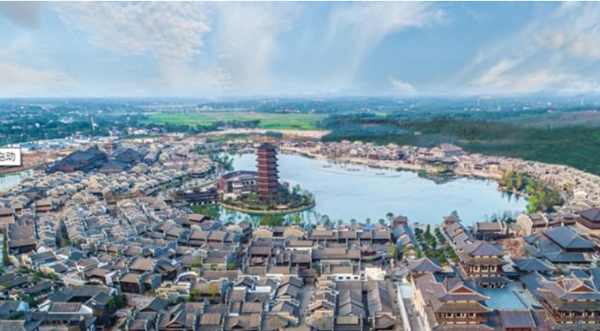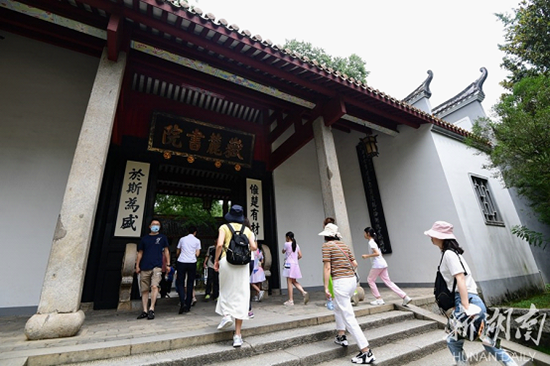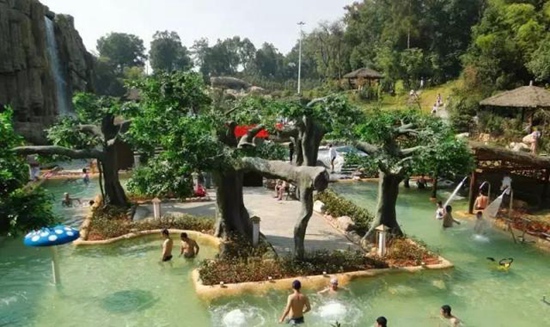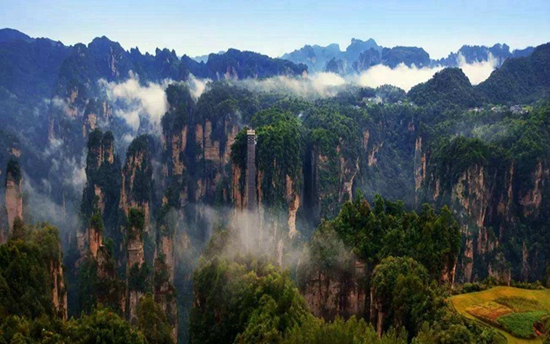Hengshan Mountain
Mt. Hengshan, also known as Southern Heights Mountain (Nanyue shan), is located about 120km south of Changsha. It is one of the five sacred Buddhist mountains in China, although much of the mountain is also dedicated to Taoist belief. The mountain extends for 80 kilometers and there are a total of 72 peaks in all, the highest of which, the Wishing for Harmony Peak (Zhurong feng), rises to 1,298 meters above sea level. This is a pretty area, that is sometimes a little too popular, although filled with enough charming Buddhist and Taoist temples, some dating back over 1000 years, and pretty scenery to make it worth your while.
At the foot of the mountain stands the biggest temple in southern China, the Grand Southern Heights Temple (Nanyue damiao), which covers an area of 100,000 square meters and which is the largest group of ancient buildings in Hunan Province. The original temple is said to have dated back at least as far as the Tang Dynasty (618-907 AD), although it was destroyed by fire at various stages. The present temple dates back to the Qing Dynasty (1644-1911 AD) and is based on Beijing's Imperial Palace. There are nine courtyards here, with the main hall as a highlight, at 22 meters high and supported by 72 stone pillars in tribute to the mountain's peaks. The temple, glazed in red and yellow, is linked with many other buildings and is a grand palace complex.
The area to arrive in for an ascent of the mountain is not the town of Hengshan, but a village nearby known as Nanyue. After finding accommodation (see below), you can visit the above temple and then set off into the heights (the entrance fee includes a crude, but useful, map), for a days walk that is enlivening and fun. The temples on the mountain are mostly austerely charming and small, meaning that an ascent to the top, including visiting numerous temples, and a return to the village, should not take more than around 10hrs (i.e. a long day). The most interesting of the temples here is at the peak, the Wishing for Harmony Palace (Zhurong gong), that is good for its mystical appearance, often through the mist, and the charm of its solid stone walls and iron roof. Other temples definitely worth a visit include the Wishing for the Emperor Temple (Zhusheng si), just out of the village, that was built for an unconsummated imperial visit by the Qing Emperor Kangxi, the Southern Terrace Temple (Nantai si), that was built during the Yuan Dynasty (1279-1368 AD) and is regarded as the origin of a Buddhist branch in Japan and the Fangguang Temple (Fangguang si), that is quiet and has some breathtaking views.
Hengyang Nanyue Great Temple(Nanyue Damiao)
Nanyue Great Temple is located at the end of North Street in Nanyue Guzhen under the foot of Nanyue Mountain. It was built at the reign of Emperor Kaiyuan thirteen years in Tang Dynasty.
The main hall was rebuilt according to the design and style of Beijing Imperial Palace at the reign of Emperor Guangxu 8 years (1882). It occupies a land area of 98,900 square meters altogether and the height of the palace is 72 feet.
It is the biggest and most complete ancient palace like temple in overall layout in our country’s five mountains. Nanyue Great Temple is composed of four groups of courtyards and nine buildings and maintained the Tang and Song’s artistic essence.
Nanyue Great Temple is divided into seven entrances. Each entrance possessed its own unique characteristic and purpose where it displayed the architect’s exquisite craft and skill.
Lingxin Gate, the entry gate to Nanyue Grant Temple, is 20 meters in height, 20 meters in width and 1.1 meters in thickness. It is the only stone entry gate of such height and width that remains in China. On each side of the gate, there are one side entrances to the Taoism temples and Buddhist temples. In the second courtyard of Nanyue Grant Temple, a stage called Kuixing Pavilion is built to deliver performance to entertain the Gods. The 2 meters high granite stage has been particularly designed and carved to amplify voices of the performers on the stage.
Marquis Cai Memorial is originally the residence of Cai Lun, the inventor of paper making skill in Eastern Han Dynasty. People built the memorial in the original place of the residence to memorize Cai Lun. According to Annotation to'Scripture of Hydrology and Geography' by Li Daoyuan, "Lei River passes Caizhou in northwest. The west of Caizhou is the original residence of Cai Lun, near where there is Cai Zi Pool."
On the bank of Caizi Lake in northern Leiyang City, a memorial hall was built in memory of Cai Lun (A.D. 63-121AD), the inventor of paper-making technology. It occupied an area of 408 square meters. It was made with brick and wood structure and faces the north. The memorial hall consists of three wood-brick bungalow. The hall is elegantly designed and constructed. It houses a statue of Cai Lun and a number of historical documents relating to paper-making technology. The hall is of great historical and cultural value.
It is not exactly known when Marquis Cai Memorial was begun to be built. In 1338 AD, Chen Zongyi, the governor of Leiyang city, rebuilt the memorial. Being destroyed and rebuilt for several times, the building remaining today was rebuilt in Qing Dynasty. It is simple, unsophisticated and elegant. Facing the south, it takes an area of 408 square meters and is of brick-timberwork. There are three layers and two courtyards. In the antehall, there are three small housese with green tile roof. There are corridors in the two sides. The middle axis is a paved path with cover leading to middle hall. There are also three houses in the middle and back halls, connected with walkway and corridor. Over the main door, there is a stone plaque of "Marquis Cai Memoriall", a stone couplet of "with beautiful pool and shining moon, the style of the original residence remains here".
Cai Lun invented paper-making in A.D. 105 years, made the world first plant tissue paper, rewriting the history of bamboo and cloth writing note. It became one of the four greatest inventions in ancient times of China. More than a thousand years later, the skill of paper- making is passed to the Eastern Asia and Europe.
FuShou Culture
The South Mountain (MountHengshan) is the Shou Mountain in China's Five Sacred Mountains.Its blessing and Shou culture has a long history and over a long time it is ahalidome for blessing and begging for long life. South Mountainwas called the "Shou Mountain" since the Han dynasty. Since SongHuizong left the carved stone "Shou Mountain?" in the Jinjian peak of South Mountain, the name"ShouMountain?" was popular. For thousands of years, the South Mountain has been respected as the symbol of long life and prosperity.
South Mountain has a prosperous shou mountain culture and the atmosphere is dense. Many architectures and relics are named after "shou", such as Wanshou Palace, Shouning Palace, Shoujian Bridge, Shoujian Stream, Baishou Booth, Yanshou Booth, Yanhou Village, Shoufo Hall,etc.
The Tripod is located at the top of Jiahe Peak behind the Nanyue Grant Temple. The Tripod is 9.9 meters in height and 56 tons in weight, representing the unity of the 56 nationalities in China and longevity of its people. A total of 10,000 gold characters of "Shou" (Longevity) in different Chinese writing styles are engraved on the frontispiece of the Tripod, with the biggest cursive script "shou" written by Chairman Mao Zedong. According to the Guinness World Records, the tripod is the tallest, heaviest and largest of its kind in the world.









